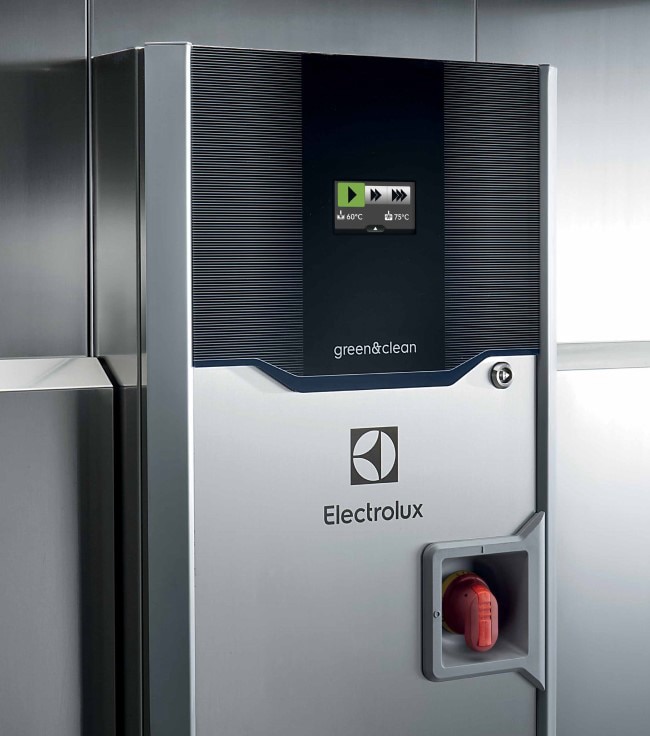
Electrolux is committed to control and reduce the use of water across factories worldwide and to enhance water efficiency in products that naturally help save water in homes and businesses.
Water availability is one of the greatest challenges of our time. Globally, the demand for water is expected to increase by 55% between 2000 and 20501).
In the end of August 2018, the World Water Week conference took place in Stockholm, shedding light on issues related to water. At a session hosted at our headquarters, Electrolux representatives took the chance to present how we are working with water management and engage in a dialogue with numerous international water experts. The goal was to get their feedback on how we can continue to take the lead in this area.
“We have ambitious goals on how we will limit the use of water consumption in our own manufacturing and also on how our products should be as water-efficient as possible,” says Henrik Sundström, VP Sustainability Affairs.

Reducing water consumption in our manufacturing
Electrolux has 53 factories all over the world, consuming around 3 million cubic meters of water every year; 20 of these factories are located in water-risk areas.
Tomas Dahlman, Director Global Energy, says, “On the manufacturing side, our strategy is to reduce water consumption by 5% every year in areas of water risks. In 2018, we achieved an overall improved water efficiency in operations of 35% compared to 2015.”
One example of how we are reducing water is the “Stop the Drop” program in the EMEA region factories and offices. Launched in 2017, the program has saved over one million cubic meters of water so far.
Each EMEA-based factory has implemented a water-saving action plan including activities to monitor water usage, recycle and reuse waste water, automate irrigation, prevent water leaks, and raise awareness among employees about how they can reduce water consumption.
Improving the water efficiency of appliances
Electrolux analyzes the lifecycle impact – including that on water source – of its appliances, from cradle to grave. For all appliances, the biggest impact on water comes from the use phase, with the washing machine having the biggest water footprint.
Our appliances can make a positive impact on water consumption in a number of ways. Energy efficiency is another focus area for Electrolux, and by helping to save energy, we help to save water, as water is needed to produce electricity.
Having washing machines that take gentle care of clothes helps to save water as, on average, 2,700 liters of water going into making a single T-shirt2). Our refrigerators, such as our UltraFresh+ fridges, help keep food fresh for longer – thereby reducing food waste and the water needed to produce that food.
Dishwashers can also help save water. Washing dishes by hand uses much more water than washing them in the dishwasher. On average, washing dishes by hand consumes 100 liters of water compared to less than 10 liters if they are cleaned in a dishwasher3).
“A washing machine uses on average almost 50% less water today than 15 years ago and a dishwasher uses 22% less water, ,” explains Stefano Zuin, Electrolux Innovation Expert, Global Connectivity & Technology Organization (see related study4) for more details). Electrolux is constantly looking into ways to further reduce these numbers.
Water-saving hero
The Green & Clean rack dishwasher uses only 0.4 liters of water to clean and sanitize an entire rack of dishes.
The dishwasher uses less water, energy, detergent and rinse aid, which translates into lower running costs and less impact on the environment.
This case study is related to our promises: Achieve more with less and Improve product performance and efficiency.
Sources:
1) http://www.globalwaterforum.org/2012/05/21/water-outlook-to-2050-the-oecd-calls-for-early-and-strategic-action/
2) https://bettercotton.org/about-bci/cottons-water-footprint-how-one-t-shirt-makes-a-huge-impact-on-the-environment/
3) Richter C.P. 2011. Usage of dishwashers: observation of consumer habits in the domestic environment. Int. J. of Consumers Studies, 35(2):180-186.
4) Boyano A., Espinosa, N., Villanueva A., Follow-up of the preparatory study for Ecodesign and Energy Label for household washing machines and household washer dryers, EUR 28807 EN, Publications Office of the European Union, Luxembourg, 2017, ISBN 978-92-79-73894-4, doi:10.2760/954441, JRC108583.
Electrolux
Electrolux shapes living for the better by reinventing taste, care and wellbeing experiences that make life more enjoyable and sustainable for millions of people. Through our brands, including Electrolux, AEG and Frigidaire, we sell more than 60 million household and professional products in more than 150 markets every year.
S:t Göransgatan 143
SE-105 45 Stockholm, Sweden